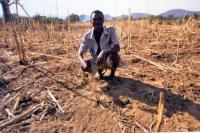The number of natural disasters in the United States (pdf) has more than doubled since 1980 according to a new report released by Munich Re, one of the largest reinsurance companies in the world.
This graph says it all:
Natural Disasters and Climate Change
While climate change cannot be linked to any individual weather event, it is widely accepted that warmer temperatures associated with climate change cause more extreme weather. “The year is following the long-term trend towards more weather catastrophes, which is influenced by climate change,” said Torsten Jeworrek, a Munich Re board member.
On climate change and natural disasters Joe Romm at Climate Progress recently wrote that:
“… the tornados and floods battering the country with almost unimaginable severity are the early tantrums of an angry planet. Under this reading, this season of natural disasters shows that climate change has arrived ahead of schedule, much to the disappointment of those who hoped that fire, drought, violent weather and the other predicted impacts of global warming were a problem only for future generations.”
In last year’s final report of the Intergovernmental Panel on Climate Change (IPCC), the world’s top climate scientists concluded (pdf.) that human influences have:
– likely contributed to changes in wind patters, affecting extra-tropical storm tracks and temperature patterns.
– likely increased temperatures of extreme hot nights, cold nights and cold days.
– more likely than not increased rick of heat waves, area affected by drought since the 1970’s and frequency of heavy precipitation events.
The IPCC scientists use a “liklihood scale” when drawing conclusions in their reports:
Virtually likely means more than 99% probability of occurence.
Very likely means more than 90% probability
Likely means more than 66% probability
About as likely as not means 33 to 66% probability
Unlikely means less than 33% probability
Subscribe to our newsletter
Stay up to date with DeSmog news and alerts







